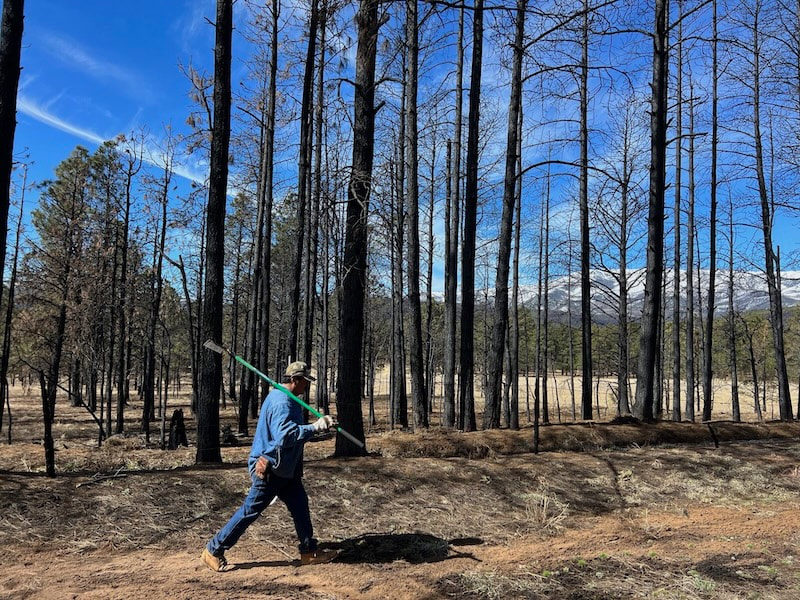|
While dozens of New Mexico acequias continue reckoning with damage from natural disasters over the last three years, they are making progress, according to officials helping them navigate multiple layers of bureaucracy.
Disasters like the Hermits Peak-Calf Canyon Fire near Las Vegas in 2022, along with the South Fork and Salt fires in Ruidoso and the Rio Chama Flooding in Rio Arriba County last year, resulted in damage to 150 acequias, according to Paula Garcia, executive director of the New Mexico Acequia Association. That amounts to about one-sixth of the state’s roughly 900 acequias. Garcia gave a presentation to members of the Legislature’s interim Water and Natural Resources Committee, which is meeting Tuesday and Wednesday in Las Vegas, a town of about 12,000 that continues to grapple with the aftermath of the Hermits Peak-Calf Canyon Fire, particularly when it comes to post-fire flooding and potential drinking water contamination. The presentation occurs as President Donald Trump’s administration mulls deep cuts to the Federal Emergency Management Agency and the potential end of disaster declarations that keep certain emergency funding streams flowing to individuals and public entities. It also comes after dozens of people were fired locally from the Natural Resources Conservation Service, a federal agency that funds emergency watershed repair and other programs acequias rely on. Last week, Western governors agreed to explore formalizing inter-state partnerships to address the aftermath of post-fire flooding, a concern they dedicated an entire panel to during the annual Western Governors’ Association conference in Santa Fe. Agriculture that relies on acequias in and around the burn scar remains largely halted more than three years after the Hermits Peak-Calf Canyon Fire, Garcia said, and every rainstorm brings the threat that acequias will flood or fill with silt that flows off fire-scarred mountainsides. But she said her nonprofit organization and state government agencies are making progress when it comes to finally untangling a complicated federal bureaucracy that was initially unfamiliar with acequias and is still inflexible when it comes to ongoing flooding. “I would like for FEMA to clean up the bureaucracy and red tape, but we’re managing it now,” Garcia said. One major hurdle acequias faced concerned upfront costs they must produce before work can be completed, Garcia said. Even though state or federal agencies reimburse most or all costs, even modest upfront costs are often insurmountable for the small, volunteer-led irrigation canals. As such, more than 100 acequias statewide have sought help from the NRCS’ Emergency Watershed Protection Program, Garcia said, largely because that program allows acequias to offload the paperwork to a local sponsor like a county or a local soil and water conservation district. Thanks to a partnership between FEMA and state agencies, the state Transportation Department has entered into agreements with about 70 statewide acequias, including 54 in the Hermits Peak-Calf Canyon Fire burn scar, to allow the DOT to remove debris from silted-in acequias. FEMA then reimburses DOT for the associated costs. About 67 Hermits Peak-Calf Canyon acequias also have pending claims with the FEMA office overseeing a $5.45 billion fund aimed to compensate victims of the fire, according to Garcia’s presentation. Garcia called on the state Legislature to find ways to help acequias pay the upfront costs and to formalize a system to remove debris from acequias. She also called on the state to create its own version of the Emergency Watershed Protection program, which is popular among acequias and also reliant on an agency undergoing staffing cuts. According to various reports, NRCS laid off at least 35 people locally. “NRCS is a really wonderful agency, and it’s tragic to see those cuts,” Garcia said. “I think there’ll be implications for these programs if those cuts continue.”
0 Comments
Your comment will be posted after it is approved.
Leave a Reply. |
Submit your ideas for local feature articles
Profiles Gardening Recipes Observations Birding Essays Hiking AuthorsYou! Archives
October 2025
Categories
All
|

 RSS Feed
RSS Feed